 — Recommendations are independently chosen by Reviewed’s editors. Purchases you make through our links may earn us a commission.
— Recommendations are independently chosen by Reviewed’s editors. Purchases you make through our links may earn us a commission.While laptops and tablets get a lot of attention these days, kicking it old school with a mechanical pencil is a great way to round out the tools you use as part of your daily writing routine.
Even if you already have a go-to pen, you’ll appreciate having a reliable mechanical pencil on hand, whenever you write something that may need to be erased.
After four weeks of researching the top products on the market and testing each one, we can tell you that the Pentel Kerry (available at Amazon for $12.59) is the best mechanical pencil you can buy. It looks as good as it writes.
Here are the best mechanical pencils we tested ranked, in order:
- Pentel Kerry
- Rotring 600
- Rotring 800
- Uni Kuru Toga Roulette
- Pilot Dr. Grip G-Spec Shaker Mechanical Pencil
- Staedtler 925-05 05
- Pentel Twist-Erase Click
- Tombow Mono Graph Shaker
- Lamy 2000
- Zebra Pen M-301 Stainless Steel Mechanical Pencil
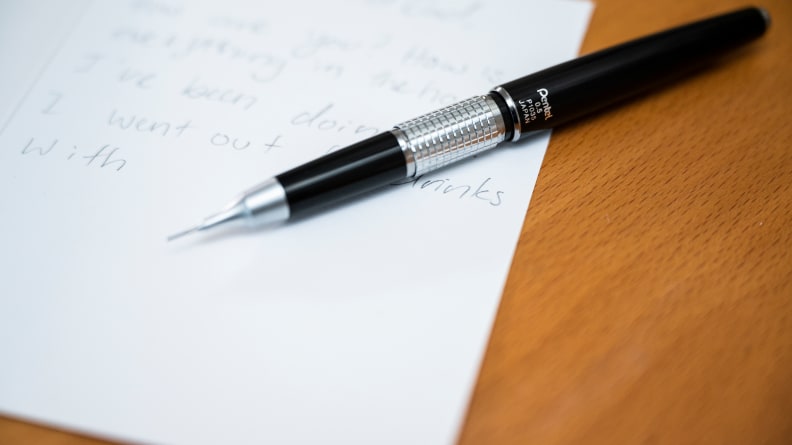

The Pentel Kerry is the best mechanical pencil, for most people.
With a knurled metal highlight in the middle of its plastic shaft, the Pentel Kerry looks like something you’d find on an executive’s desk, especially when capped. The cap protects the pencil tip when not in use, keeping it safe from breakage. Remove the cap from the business end of the pencil and post it on the end of its barrel and the Kerry becomes a well-balanced writing instrument that is long enough to accommodate most hand sizes and writing styles.
The Kerry has an all-metal mechanism and nock (the part of the mechanism that advances the lead inside of the pencil). When advancing lead, the action is both consistent and smooth. Overall, the Kerry performed well during testing. It writes well on a variety of paper—it was one of the only pencils in our test group that didn’t tear the basic Hilroy notebook paper. No matter which paper we tested it on, there was no noticeable drag or change in line width as you write and dull the lead. When used for drawing, the Kerry provided good line variation and shading.
We loved that the Kerry’s cap has a button that activates the mechanism on the barrel to advance its lead. This makes it unnecessary to unpost the cap as you write. The eraser is conveniently tucked in the plunger and works well, despite its small size.
The only issue we had with this pencil is that its grip is smooth, which can make it slick in your hand while writing.
Pros
-
All-metal mechanisms
-
Clever design
Cons
-
Surface becomes slick during long writing sessions.
How We Tested Mechanical Pencils
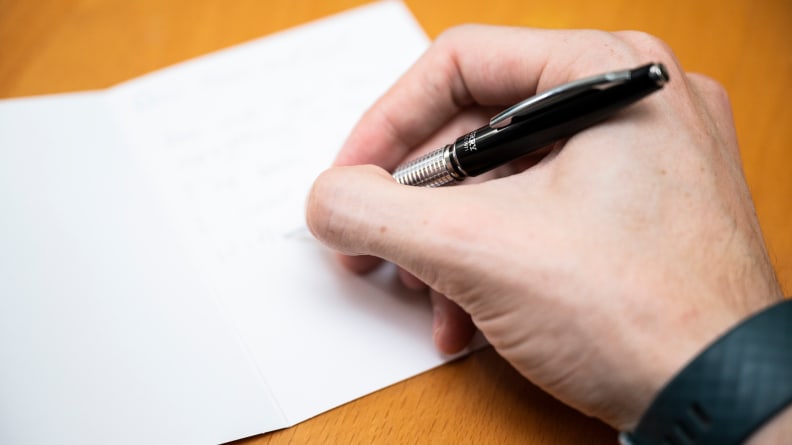
The only way to test mechanical pencils is to use them to write and draw—a lot.
The Tester
My name’s Leah Fitzgerald. I’m a straight-up nerd when it comes to writing utensils.
I was that kid with her crayons sorted by color in a small toolbox snagged from the barn. I still keep my huge stash of pens, highlighters, markers and pencils (and, yes, crayons for coloring) sorted by type, though I’ve graduated to a nice pen roll for my fountain pens. Bleed-through is my pet peeve and a buttery soft page in a fresh notebook is my happy place.
I fell in love with mechanical pencils after a miserable cold snap froze all my ballpoint pens when I was a young reporter in Quebec.
The Tests
Each one of the mechanical pencils in this guide was tested over the course of a full day’s worth of work, longhand letter writing, and note taking for a series of meetings. We also drew some diagrams with them and used a ruler and a helix for making circles. If the pencil came sporting an eraser, we tested it for how well it erased a heavier scribble of graphite and regular writing.
During testing, we used each mechanical pencil, we wrote on a variety of different paper types, including:
- A Hilroy notebook
- A Field Notes notepad
- A Rhodia Dot Pad,
- A Strathmore Drawing pad.
To test durability, each of the pencils was allowed to roll off a surface and fall a distance of 32.25 inches, onto a hardwood floor. After each of the pencils took the plunge, the lead inside was examined for breakage. Any damage to the pencils themselves was noted.
All of the pencils tested used 0.5 mm lead, except the Zebra M 301, which is available as 0.7 mm. We tested a 0.5 mm lead because it is widely available. Additionally, thinner lead can show any breakage issues more easily than its thicker counterpart.
How To Shop For A Mechanical Pencil
We stand by the options we’ve recommended in this guide. However, if you want to head out to buy a mechanical pencil on your own, there’s a few things you should look for.
Build Quality: Good craftsmanship will keep your pencil in your hand for decades. A sturdy barrel with minimal give, machined parts (metal or plastic) that fit tightly together, with no visible seams (potential weak points) are all signs of a solidly built pencil.
Balance: It’s personal where you prefer the weight, but a well-balanced pencil encourages a more relaxed hand position when writing, which reduces fatigue.
Easy to Fill: No fiddly mechanisms here. All of the pencils reviewed have a simple access point from the end of the pencil: remove the plug or eraser and add more lead.
Comfortable Grip: It’s very much personal - do you need a straight side or a taper? Do you prefer smooth or textured? Do you want some extra cushioning?
Lead Size: Not all pencils are available in all lead sizes. If you want a special wider or narrower lead, your options will change from the standard 0.5 or 0.7 mm lead options. Narrower leads are great for precision drawing and drafting uses, and people with small handwriting often prefer fine and extra-fine equivalents. Wider leads give a bolder line for drawing and tracing. The wider leads are also more resilient and might fare better for anyone with a heavier hand when they write.
How Do Mechanical Pencils Work?
Inside the barrel of a mechanical pencil is a tube that holds leads—usually three, but sometimes more. When the tip of the lead you’re using starts growing dull or running out, additional lead can be advanced by clicking the button on the pencil, which, in turn, activates a mechanism called a clutch. The clutch grabs onto the lead inside of the pencil and pulls or pushes it through the pipe at the tip.
No matter which mechanical pencil you end up using, it’ll likely contain these parts:
- Plunger: The basic mechanism in most pencils. Uses gears powered by pushing the plunger to pull the lead through the pipe.
- Shake: A weight inside the mechanism creates the movement pulling the lead through the pipe.
- Click: Like a plunger, but the gears are driven from the side of the pencil rather than the top.
- Clutch: Some pencils have a clutch mechanism, which allows shorter lengths of lead to be fed through the pencil. This is more common in higher-end drafting pencils that use thin lead - it allows more of the lead to be used by the pencil.
- Pipe/Lead Sleeve: The thin tube that comes out of the barrel pencil, where the lead comes out. It supports the lead as the pencil moves along the paper, and is retractable on some pencils to reduce breakage.
All mechanical pencils need a certain length of lead available (usually at least a centimeter) in their clutch to maintain a grip on as you write. The last, short piece of lead will slip back as you write in almost all pencils. When this happens, it’s best to eject it and start a fresh lead for the best performance.
Are Mechanical Pencils And Drafting Pencils The Same?
Drafting pencils support a much wider variety of lead sizes than mechanical pencils. Additionally, drafting pencils have a longer pipe, which makes them ideal for precision work as it allows a better view of what's happening on the paper.
Should I Use Graphite Or Lead Refills?
Lead is a misnomer as actual lead hasn’t been used for writing since the ancient Romans and Egyptians used a lead stylus to write on papyrus.
When it comes to modern pencils, the black "lead" comes from carbon, either in the form of graphite or carbon mixed with a binder. Carbon refills will make what you write appear darker on the page. A graphite refill may have some binder in it as well. Carbon is often bound with clay, with higher proportions of clay to carbon leading to harder leads. Softer leads contain either wax or a polymer to bind the carbon or graphite. Some refills (Pentel Super Polymer, for instance) contain a core to make the lead more flexible and resilient when writing.
Finer quality leads for mechanical pencils are available in many more grades than the standard HB (or No. 2 equivalent). H is for hardness and B is for boldness. H leads get harder and lighter as the numbers go up, while B leads will get softer and darker as the numbers increase. Lead hardness also determines how dark a line the pencil will lay down. Leads on the B scale will put down darker lines (although you can create light lines with them as well,) but will also be easier to smudge.
A Note On Paper Quality
A good quality paper can make low-end mechanical pencils perform well.
The smooth texture of the Rhodia pad we used for testing, for example, made it difficult to notice any drag or catching from any of the pencils. The Hilroy Quad-Rule notebook, on the other hand, was noticeably rougher to the touch. This affected the way most of the pencils wrote, even causing some of them to snag the paper and tear it. This wasn’t the case, however, with the medium texture Strathmore Drawing pad used in testing. The thicker paper prevented the snagging issue, but it did make it clear again which leads were prone to drag (and noise in a quiet room) as we wrote and drew.
Other Mechanical Pencils We Tested

A solid, smooth writer on every paper tested, the Rotring 600 has a sturdy, full metal body with a matte finish. Its knurled grip is comfortable and easy to hold, even though the pencil’s diameter is on the smaller side, compared to others we tested for this guide.. The 600’s balance is what makes it a great pencil: it’s easy to use for long periods of time, and its lead doesn’t seem to dull as you write. We also liked that its advance mechanism is smooth and consistent.
From a design standpoint, the 600 definitely reads more like an engineering tool than an elegant writing instrument.
Unfortunately, the 600’s design doesn’t include a retractable pipe (where the lead comes out of the tip of the pencil). This makes it less than ideal as an everyday carry. Without a pocket protector or a makeshift cap (Bic Crystal pen caps are supposed to be a good fit), this pencil will leave lead marks on your stuff if you forget to retract the lead before stowing it.
Pros
-
smooth, solid performance
-
All metal body
Cons
-
No retractable pipe

The Rotring 800’s pipe can be retracted into its barrel by turning the top of the pencil. This is the heaviest of the pencils tested, with a sturdy metal build. It has a matte finish, solid metal build, and knurled grip with great balance and an easy loading mechanism. The 800 is one of the more expensive pencils tested but protecting your stuff from stray pencil marks may make it worth it for an everyday carry.
While the balance on this pencil is great, it did catch on the basic Hilroy notebook paper.
Pros
-
Retractable pipe
-
Well-balanced
Cons
-
performs poorly on low-quality paper
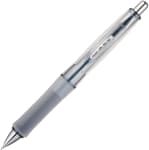
The Pilot Dr. Grip G-Spec Shaker Mechanical Pencil has a chunky gel grip that makes it a lot more comfortable to use during longer writing sessions. It’s made mostly out of plastic, but it doesn’t feel flimsy while writing. It’s definitely still a weighty pencil thanks to the grip, coming in at 20 g. Its balance is more focused towards the tip but it remains comfortable to write with.
The Dr. Grip’s advance mechanism is smooth and, happily, makes it possible to release the clutch and push the excess lead back in. The eraser under the cap is small but effective. During testing, it performed well on all of the paper stocks in our test group.
That said, it does not give the control that a pencil with a smaller barrel and grip, such as the Rotring 600, can. If you’re looking for a comfortable writing experience, though, this is a good option.
Pros
-
Comfortable to write with
-
Smooth mechanism
Cons
-
Circumference too larger for smaller hands

The Uni Kuru Toga has a special rotation mechanism that turns the lead as you write, keeping the pencil’s lead from developing a flat edge. While it writes well, we’re not sure that there was any advantage to this feature. Advancing the Kuru Toga’s lead is smooth but the rotating mechanism means that shorter pieces of lead can get jammed. During testing, we found that this pencil writes well on most paper, albeit, there were some minor issues with snagging.
The Kuru Toga is available in several models with slight variations in the clip and barrel—plastic and metal are both available.
Pros
-
Adequate writing performance
Cons
-
Prone to jamming
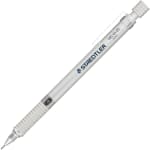
Staedtler makes a broad range of products for drawing and drafting. The 925-25 05 is on the lower end of their range of mechanical pencils. It writes well, has a lovely balance, and a nice knurled grip. The barrel is about the same width as a standard ballpoint pen and the tip allows for a good view of your paper when you’re doing detailed work.
The 925-25 05 ‘S build quality feels nice. It’s a little lighter than some of the other pencils in this guide, but still feels well balanced in the hand. It comes with a wire tucked in with the eraser for clearing any jams (very handy) and is easy to load. The eraser provided does its job cleanly.
Unfortunately, during drop testing, the 925-25 05 landed tip down--the heaviest point on the pencil--bending the pipe where the lead comes out. Up until then, it had performed well on all paper and the mechanism nocks the lead smoothly and consistently.
Pros
-
Knurled grip
-
Well-balanced
Cons
-
Lead breaks easily when dropped
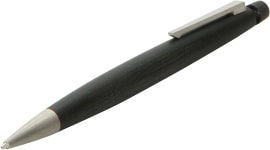
The Lamy 2000 we tested has a beautiful dark grey matte finish on the torpedo-shaped barrel. The grip is tapered and feels nice in the hand. The clip is squared-off, in contrast to the curved lines of the pencil itself, in a complimentary silver. It’s a beautiful looking pencil... that fell apart in my hands the first time we tried to load lead. The problem was user error: the Lamy 2000 is designed to twist apart to allow access to its tip for clearing blockages. But twist it apart and well, you get the idea.
Loading lead into the pencil’s mechanism follows the same process as the other pencils in this guide do: remove the plunger and eraser, insert more lead into the body. It’ll be some time before Lamy 2000 owners will have to worry about that though: this pencil came preloaded with the most lead out of any of the products we tested for this guide. We found that it writes well on better quality paper, such as the Rhodia pad, but it’s definitely prettier to look at than it is to use.
Pros
-
Modern Design
-
Holds plenty of lead
Cons
-
Underwhelming performance on inexpensive paper

The Pentel Twist Erase Click is a great option for anyone who does a lot of erasing as they write. Instead of having to remove the pencil’s plunger, the pencil’s eraser mechanism twists up. This reduces the possibility of losing its cap. The Twist Erase’s eraser is the largest included with any of the pencils we tested for this guide and worked well on most of the paper stock we used during testing. When erasing on our Strathmore art pad, it had a difficult time cleanly removing the lines. However, as none of the erasers we tested performed well on the Strathmore’s textured surface (a kneadable eraser is a better bet for art paper,) It’s difficult to view this as a failing.
On the writing side of things, the Twist Erase’s internal mechanism is smooth and consistent when advancing lead though we did not find the side click mechanism convenient - it’s not quite in the right spot for me to be able to use it without changing the position of the pencil in my hand. It does snag if you press hard on thinner paper, but it’s still a solid performer with a large eraser that erases cleanly, making it more of a workhorse than some of the other pencils tested.
Pros
-
Large eraser
-
Smooth mechanism
Cons
-
Frequently catches on paper while writing

The Tombow Mono Graph Shaker pencil works unlike any other mechanical pencil in this guide: shaking the pencil up and down advances its lead so you can keep on writing. It’s a clever idea, but it’s a little too easy to trigger by accident. On several occasions, we found myself with more lead at the end of the Tombow than we needed. However, this is easy to remedy: simply hold open the Tom Bow’s clutch, and the excess lead can be slid back into the pencil’s barrel. The shaking mechanism also locks by sliding the clip up, preventing the mechanism from sliding inside the barrel of the pencil.
The Tombow was an average performer on all the paper we tested it on. The lead that comes in the pencil is smooth and strong. The pencil's barrel is slightly wider than those of the other mechanical pencils in the guide. Unfortunately, its larger circumference is wasted: with no tapering and the barrel’s being made of slick plastic, any potential ergonomic advantage is lost.
Pros
-
Average writing performance
Cons
-
Lead too easily advanced by accident.

Zebra’s M 301 mechanical pencils come in a pack of four, or in a box of 12.
Made of stainless steel with a rubberized grip, at 0.321 ounces, it was the lightest of the pencils in this guide. We liked the balance of this pencil but, unfortunately, it’s light weight reduces the feedback from writing. Feedback between a writing utensil and the paper makes it easier to sense how hard you're pressing, and pressing harder with a pencil leads to lead breaks, and hand fatigue in general.
During testing, the M 301 wrote well on all of our paper stock. It’s worth noting, that while it didn’t snag on any of the paper, the lead that the pencil ships with smeared on the thin paper of our Hilroy notebook, more than any other pencil we tested.
It’s worth noting that, while none of the leads broke during our drop test, the writing performance of the M 301 was affected. When using it, post-test, the lead felt like it was splintering or softening as we wrote.
Pros
-
Lightweight
Cons
-
Lead smears on paper
-
Minimal writing feedback
-
Poor drop test performance
